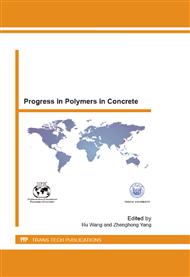[1]
H.J. Chen, T. Yen, K.H. Chen,Use of building rubbles as recycled aggregates, Cem Concr Res. 33 (2003) 125-132.
DOI: 10.1016/s0008-8846(02)00938-9
Google Scholar
[2]
F.M. Khalaf, A.S. DeVenny, Properties of new and recycled clay brick aggregates for use in concrete, J Mater Civil Eng. 17 (2005) 456-464.
DOI: 10.1061/(asce)0899-1561(2005)17:4(456)
Google Scholar
[3]
F.M. Khalaf, A.S. DeVenny, Recycling of demolished masonry rubble as coarse aggregate in concrete: review, J Mater Civil Eng. 16 (2004) 331-340.
DOI: 10.1061/(asce)0899-1561(2004)16:4(331)
Google Scholar
[4]
J.S. Ryu, An experimental study on the effect of recycled aggregate on concrete properties, Mag Concr Res. 54 (2002) 7-12.
Google Scholar
[5]
C. Hoffmann, S. Schubert, A. Leemann, Influence of variations in composition on the concrete properties and their use as structural material. Constr Build Mat. 35 (2012) 701-709.
DOI: 10.1016/j.conbuildmat.2011.10.007
Google Scholar
[6]
M. Etxeberria, E. Vázquez, A. Marí, M. Barra, Influence of amount of RCA and production process on properties of recycled aggregate concrete, Cem Concr Res. 37 (2007) 735-742.
DOI: 10.1016/j.cemconres.2007.02.002
Google Scholar
[7]
L. Evangelista, J. De Brito, Durability performance of concrete made with fine recycled concrete aggregates, Cement and Concrete Composites. 32 (2010) 9-14.
DOI: 10.1016/j.cemconcomp.2009.09.005
Google Scholar
[8]
S. Nagataki, Properties of Recycled Aggregate and Recycled Aggregate Concrete, International Workshop on Recycled Concrete. (2000)
DOI: 10.1201/9781003257097-1
Google Scholar
[9]
T.C. Hansen, Elasticity and drying shrinkage of recycled aggregate concrete, ACI journal, 82 (1985), p. JL82-52
DOI: 10.14359/10374
Google Scholar
[10]
T.C. Hansen, H. Narud, Strength of recycled concrete made from crushed concrete coarse aggregate, Concrete International-Design and Construction. 5 (1983) 79-83
Google Scholar
[11]
T.C. Hansen, Recycled aggregate and recycled aggregate concrete, Second State-of-the-art Report developments 1945–1985, Materials and structures. 111 (1986).
DOI: 10.1007/bf02472036
Google Scholar
[12]
S. Hasaba, M. Kawamura, K. Torik, K. Takemoto, Drying shrinkage and durability of the concrete made of recycled concrete aggregate, Transactions of the Japan Concrete Institute. 3 (1981) 55-60.
Google Scholar
[13]
T. Mukai, H. Koizumi Study on reuse of waste concrete for aggregate of concrete, Paper Presented at a Seminar on "Energy and Resources Conservation in Concrete Technology", Japan–US Co-operative Science Prog, San Francisco (1979)
Google Scholar
[13]
N. Otsuki, S.I Miyazato., W.Yodsudjai Influence of Recycled Aggregate on Interfacial Transition Zone, Strength, Chloride Penetration and Carbonation of Concrete. J Mater Civil Eng. 15 (2003) 443-451.
DOI: 10.1061/(asce)0899-1561(2003)15:5(443)
Google Scholar
[14]
D. Kong, T. Lei, J. Zheng, C. Ma, Jun Jiang, J. Jiang, Effect and mechanism of surface-coating pozzalanics materials around aggregate on properties and ITZ microstructure of recycled aggregate concrete. Constr. and Build. Mat. 24 (2010) 701-708
DOI: 10.1016/j.conbuildmat.2009.10.038
Google Scholar
[15]
V.W.Y Tam,., C.M. Tam, Y. Wang, Optimization on proportion for recycled aggregate in concrete using two-stage mixing approach. Constr and Build Mat.. 21 (2007) 1928-1939
DOI: 10.1016/j.conbuildmat.2006.05.040
Google Scholar
[16]
S.C Kou., C.S Poon., Etxeberria M., Influence of recycled aggregates on long term mechanical properties and pore size distribution of concrete. Cem Concr Comp. 33 (2011) 286-291
DOI: 10.1016/j.cemconcomp.2010.10.003
Google Scholar
[17]
V. Spaeth, JP Lecomte, MP Delplancke, Development of cement materials by incorporation WR additives, RBM, Aedificatio publishers. 16 (2010) 315-324
Google Scholar
[18]
Zhao T, Wittmann F H., Jiang R, Li W, Application of silane-based compounds for the production of integral water repellent concrete, HVI, 6th International conference on WR treatment of building materials. (2011) 137-144.
Google Scholar


